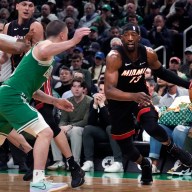In a strong Week 16 slate, perhaps the most fascinating game is the final one, when the Minnesota Vikings host the Green Bay Packers on Monday night.
No one would claim that Kirk Cousins is a better quarterback than Aaron Rodgers, but he has played the position better for most of this season, making for an interesting clash of styles. That’s where we begin.
1. The fascinating Rodgers-Cousins dichotomy
Cousins is less talented, less heralded and has a lower ceiling than Rodgers. There’s no debating that. But since a shaky first two weeks, he has executed Minnesota’s offense with extreme precision.
Coordinator Kevin Stefanski and adviser Gary Kubiak have made that job easier with a defined, balanced approach. The run game is a sustaining force almost every week, and the wealth of complementary play-action and screen concepts provide both a stable floor and (usually) a few explosive plays.
Cousins has maximized the scheme by reading the field clearly, working diligently through reads, delivering on time and throwing well on the run, especially while rolling left. He’s not carrying the offense, but he has produced steadily despite Adam Thielen’s lengthy absence and a few injuries at running back.
On the other end of the spectrum, Rodgers, despite his highs, is often maddening to watch on tape. His skill set should make him a coach’s dream, if he would only trust play designs more consistently. But he executes Matt LaFleur’s scheme — which isn’t very different from Minnesota’s — selectively, too often reverting to playground tendencies despite a basic throw coming open.
It’s an atypical form of “hero ball.” Rodgers isn’t a gambler trying to force throws into impossible windows — he’s more of a perfectionist with overflowing self-confidence, believing he can conjure a better play than the one that’s already there to be made.
Minnesota’s cornerbacks are exploitable, and it wouldn’t surprise if Rodgers had a big night Monday. But Cousins’ approach feels more sustainable — even with the Packers winning — which makes the Vikings’ offense the more consistent unit.
2. Philosophy change for Moore, Cowboys?
The biggest takeaway from the Dallas Cowboys’ stomping of the Los Angeles Rams last week was offensive coordinator Kellen Moore’s clear commitment to the running game and Ezekiel Elliott.
Moore has leaned pass heavy most of the season, but he gave Elliott 22 carries through only three quarters Sunday. It absolutely paid off, with Dallas racking up season highs of 45 carries and 263 rushing yards.
Was that a one-week game plan or a permanent philosophical shift? We should get a good answer Sunday, as the Philadelphia Eagles’ defense is far better against the run (3.99 yards per carry allowed, seventh) than the pass (6.96 yards per attempt, 21st).
Dak Prescott is battling shoulder and finger injuries, perhaps giving Moore more reason to lean on the run. The Cowboys’ offensive line is also thriving at the perfect time, dominating in the run game last week on a level that few other teams can match. The group can run a litany of concepts with proper technique and execution, and its ceiling is good enough to handle almost any defensive front.
Despite Prescott’s improvement while carrying a heavier load this season, it feels like these Cowboys might be shifting back to their style from Prescott’s first three seasons.
3. Bills’ path past the Patriots is on the ground
The Buffalo Bills’ defense did more than enough to win in a Week 4 meeting with the New England Patriots. The offense, however, was a mess, as Josh Allen threw three interceptions before being concussed.
Allen has cut back the turnovers since, but the last two weeks have reminded everyone he still has a long way to go to be a consistent passer. Against an outstanding Patriots pass defense, coordinator Brian Daboll will need the run game to carry the load.
That’s certainly possible. Buffalo’s offensive line has been better run blocking than pass protecting all season. It has been particularly effective on pin-and-pull runs, getting center Mitch Morse and either left guard Quinton Spain or right guard Jon Feliciano in space. Rookie running back Devin Singletary has been excellent since taking over as the full-time starter, showing a combination of vision, agility and physicality that reminds many of Maurice Jones-Drew.
The Bills rushed for 135 yards on just 22 carries (6.1 average) in Week 4, despite Singletary (hamstring) sitting out and Allen rushing just five times, two of which came on scrambles. Buffalo might not want to risk Allen’s health, but he could bring major upside in the run game.
In the Patriots’ Week 9 loss to the Ravens, Baltimore leveraged Lamar Jackson’s legs beautifully against New England’s front, changing up which defender was left unblocked and deploying tight ends and a fullback in a variety of ways. The Bills have similar personnel, with Allen’s legs and several moveable blockers at tight end. Daboll should be studying Ravens coordinator Greg Roman’s plan very closely.
4. San Francisco’s worrisome hole at center
We touched last week on the San Francisco 49ers’ growing list of major injuries, and one in particular — losing center Weston Richburg for the season — has already reared its ugly head.
Falcons defensive tackle Grady Jarrett flat out embarrassed the 49ers’ interior last week, blowing up blocks and penetrating in the run game while harassing Jimmy Garoppolo for a series of hurries despite not getting home for a sack. Replacement starting center Ben Garland was not the only problem, but he was physically overmatched too often.
Now Garland has to face the league’s most disruptive player, Aaron Donald. Los Angeles Rams defensive coordinator Wade Phillips will put Donald at nose tackle on a few obvious passing downs, and may even do so on occasional early downs. Either way, expect the two-time reigning Defensive Player of the Year to be shooting gaps from the first snap.
That’s where Kyle Shanahan’s plan will be critical. His scheme has the volume and creativity in the run game to keep Donald off-balance, but there’s only so much that can be done if the interior implodes every other snap.
Expect Shanahan to mix in trap runs — inviting Donald upfield only to “wham” block him with a puller — and tosses to the perimeter early to make Donald think. Garland showed good mobility in New Orleans two weeks ago, so some pin-and-pull concepts would also make sense.
5. Brees looking surprisingly spry
Drew Brees and the New Orleans Saints’ offense have exploded the last two weeks, looking five years younger.
Brees absolutely diced the Colts’ defense last week, doing most of the damage — as usual — with his mind. But he also was remarkably mobile for a soon-to-be 41-year-old, moving extremely efficiently and even making free rushers miss.
The Tennessee Titans’ defense brings many of the same principles as the Colts’ — both are predominantly zone-based (Cover-2 especially) units that play relatively simple coverages out of various disguises, often with a second-level defender coming as part of a four- or five-man rush.
The Titans lean more heavily on disguises, and they’ll need to, because Brees identified the Colts’ rotations with ease. Tennessee is also better at pressuring opposing quarterbacks, with both quality personnel and scheme.
The Saints are banged up inside, with right guard Larry Warford (knee) hurt just as left guard Andrus Peat (broken arm) nears a return. The Titans must exploit the interior with penetration from Jurrell Casey and Jeffery Simmons along with loops and stunts from linebackers Rashaan Evans, Jayon Brown and Wesley Woodyard.
–By David DeChant (@DavidDeChant), Field Level Media

















